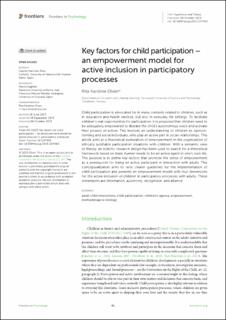| dc.contributor.author | Olsen, Rita Karoline | |
| dc.date.accessioned | 2024-03-12T07:34:54Z | |
| dc.date.available | 2024-03-12T07:34:54Z | |
| dc.date.created | 2023-11-06T10:42:16Z | |
| dc.date.issued | 2023 | |
| dc.identifier.citation | Frontiers in Psychology. 2023, 14 . | en_US |
| dc.identifier.issn | 1664-1078 | |
| dc.identifier.uri | https://hdl.handle.net/11250/3121869 | |
| dc.description.abstract | Child participation is advocated for in many contexts related to children, such as in education and health services, but also in everyday life settings. To facilitate children’s real opportunities for participation, it is proposed that children need to be adequately empowered to liberate the child’s autonomous voice and activate their powers of action. This involves an understanding of children as opinion-forming and social individuals, who play an active part in social relationships. This article aims at a theoretical exploration of empowerment in the organization of ethically justifiable participation situations with children. With a semantic view of theory, an eclectic research design has been used to search for a theoretical framework based on basic human needs to be an active agent in one’s own life. The purpose is to define key factors that promote the sense of empowerment as a prerequisite for being an active participant in interaction with adults. This conceptualization aims to raise clearer guidelines for the implementation of child participation and presents an empowerment model with four dimensions for the active inclusion of children in participatory processes with adults. These dimensions are information, autonomy, recognition, and alliance. | en_US |
| dc.language.iso | eng | en_US |
| dc.publisher | Frontiers Media | en_US |
| dc.rights | Navngivelse 4.0 Internasjonal | * |
| dc.rights.uri | http://creativecommons.org/licenses/by/4.0/deed.no | * |
| dc.title | Key factors for child participation – an empowerment model for active inclusion in participatory processes | en_US |
| dc.title.alternative | Key factors for child participation – an empowerment model for active inclusion in participatory processes | en_US |
| dc.type | Journal article | en_US |
| dc.type | Peer reviewed | en_US |
| dc.description.version | publishedVersion | en_US |
| dc.source.pagenumber | 12 | en_US |
| dc.source.volume | 14 | en_US |
| dc.source.journal | Frontiers in Psychology | en_US |
| dc.identifier.doi | 10.3389/fpsyg.2023.1247483 | |
| dc.identifier.cristin | 2192467 | |
| cristin.ispublished | true | |
| cristin.fulltext | original | |
| cristin.qualitycode | 1 | |

